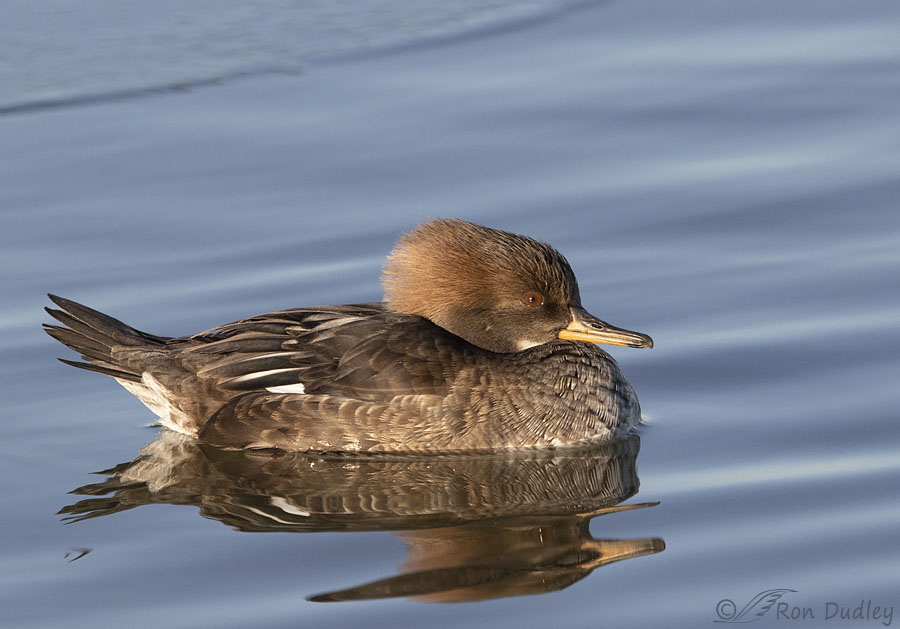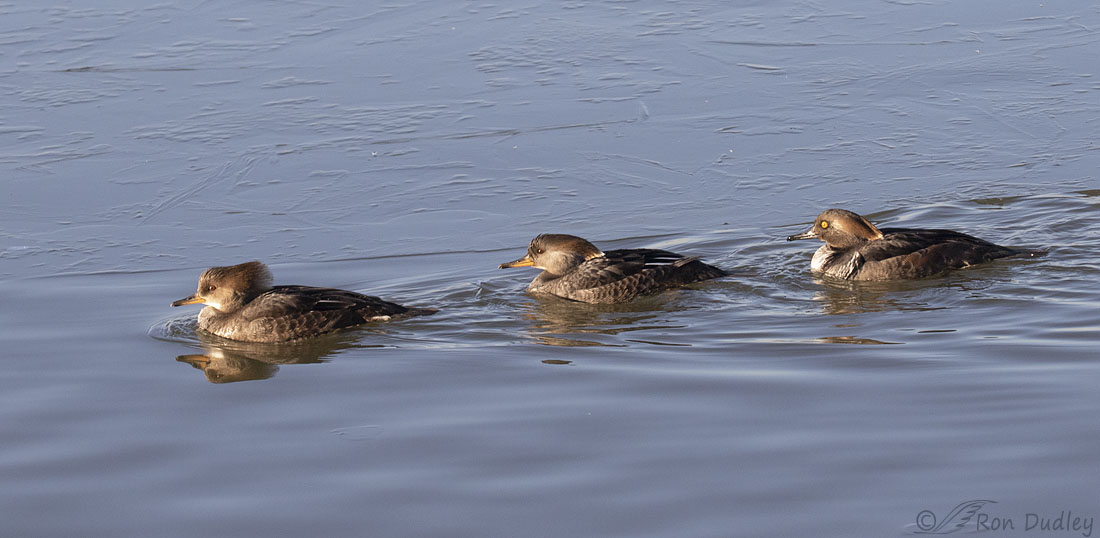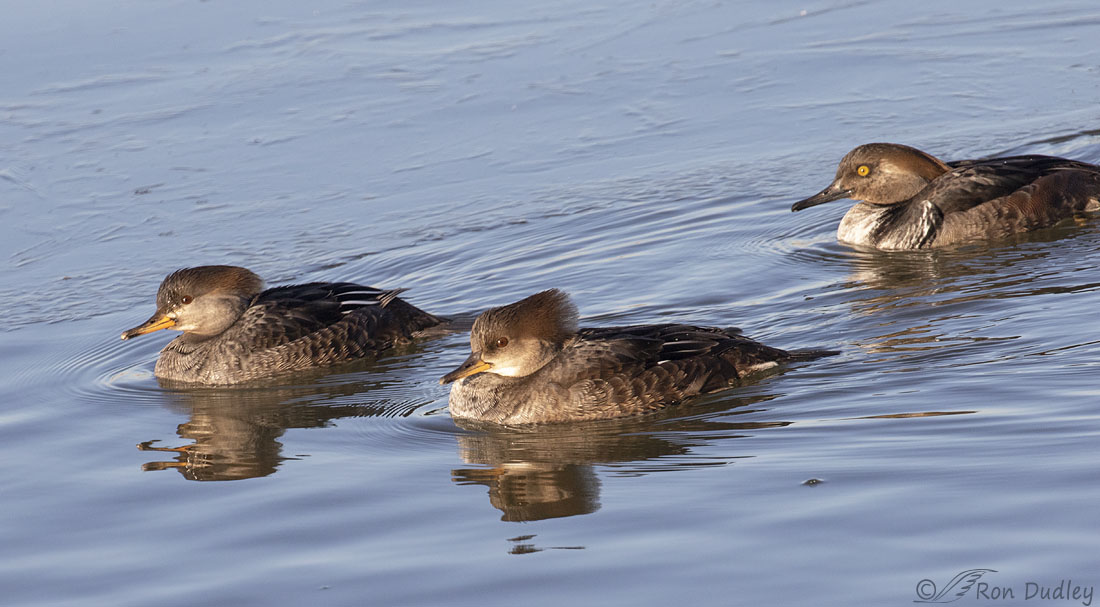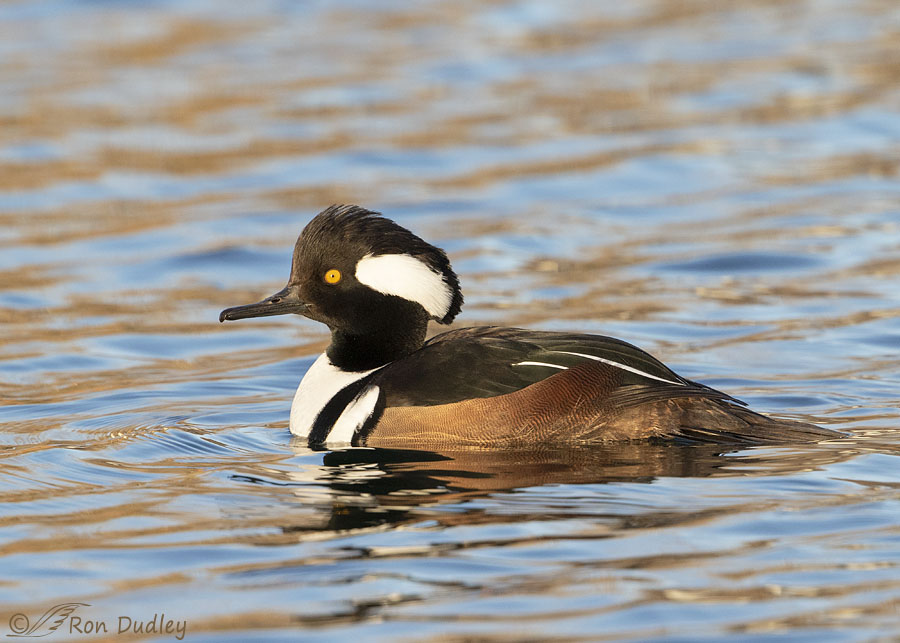Plus the only first winter drake Hooded Merganser I’ve ever seen.

1/1250, f/10, ISO 800, Canon 7D Mark II, Canon EF 500mm f/4L IS II USM + EF 1.4 III Extender, not baited, set up or called in
Three days ago I spent some time photographing three Hooded Mergansers in Davis County. This is one of the two adult females in the tight little group. The three of them were so clingy it was often difficult to get isolated shots of any single bird.
There’s nothing spectacular here, other than I think she’s a subtly beautiful little fish-eating duck. I chose to post this particular photo because of her unusual head reflection that I think resembles the head of a hammerhead shark. Then I look at it again and I see a stylized raptor head. I tend to be drawn to interesting reflections, perhaps more than I should be.
I was shooting at f/10 because I’d been trying to photograph multiple mergansers in the same frame so I needed extra depth of field. The timing was fortunate because immediately after this photo was taken the male Northern Shoveler that I posted a landing shot of two days ago flew in unexpectedly and he was so close I desperately needed that additional depth of field.
But the most interesting merganser I photographed that morning was the third bird in the group, a first winter drake.

For some reason I was having difficulty getting sharp shots of him with my big lens which is part of the reason I switched to my smaller zoom lens for a short series of photos.
Here the two adult females are in the lead with the first winter drake pulling up the rear. They were side lit but I think the lighting is good enough to clearly see at least two of the significant differences which I’ll point out below.

Wouldn’t you know it, I clipped the tail of the trailing immature male in the photo where they had the best light and detail. He’s still in juvenile plumage but he’s beginning to attain some of the distinctive blacks and whites of the adult male on his breast and flanks.
And he already has the bright yellow iris of the adult male as opposed to the brownish buff or brownish olive iris of the adult females. A few weeks before this shot was taken his eye color would have been similar to that of females of the same age.
All this is almost certainly more than many of you wanted to know about Hooded Merganser age progression but I was intrigued by this young male the instant I saw him through my lens so I wanted to learn more.
As I said at the outset he’s the first male Hooded Merganser of this age and in this plumage I’ve ever seen.
Ron
Notes:
- Looking at the range map of Hooded Mergansers I’d guess that blog readers in the southeast quadrant of the U.S. may see first winter drakes fairly often. I’d be curious about any feedback in that regard from readers.
- As an afterthought I thought I should include a photo of an adult male in breeding plumage so readers unfamiliar with the species could see what this first winter drake will look like soon. Photo below.



The difference between the female and male for me were the eye color. Love to follow you Ron. You know so much. Thanks to you for your blog.
Linda, I may not know as much as you think I do. I had to look up some of this stuff.
Talk about getting your ducks all in a row. I like the subtle beauty of the females. I especially like learning something about the age progression of the male; after all, it was age progression that brought me to your blog.
I like the subtle beauty of the females. I especially like learning something about the age progression of the male; after all, it was age progression that brought me to your blog.
Then age progression is a GOOD thing, Marty – at least in ducks. I’ve had just about enough of it myself…
They are beautiful. I love diving ducks! I wish they were here more.
I agree, April.
Excellent class today Mr. Dudley, and serendipitous, too boot. I was walking by a nearby pond two days ago and there were four male Hooded Mergansers in breeding plumage and one vexing juvenile/male/female/whatthehell. Hopefully, when I go by today they will still be there and i will have the tools to ID it.
BTW, the BotW distribution map and text for this species appear to be at odds with each other.
to boot, not too boot. The reflection: Pterodactyl-ish.
The reflection: Pterodactyl-ish.
“At odds with each other”. I’d be interested in knowing what you spotted Lyle.
And you’re right about Pterodactyl-ish. That’s probably the best one of all.
My bad. I misinterpreted the map colors.
Yet another bird wot we don’t get (she says pouting a little).
Thank you. And thank you for your observant eye and knowledge.
Of course you are drawn to interesting reflections. More than you should be? Absolutely not – says the woman who still looks for ‘shapes’ in clouds.
I have that cloud affliction too, EC. I think it makes life more interesting. And enjoyable.
Last winter I was puzzled by a male hoodie repeatedly chasing off what appeared to me to be a female hoodie. He had perhaps 5 or 6 females with him. When I looked at the photos later, I noticed the black beak that differentiates the just-beginning-to-change males to breeding plumage males. Fascinated, I took photos of the obvious changes as a number of immatures matured. Here in Denver we’ve had a good number of hoodies in the past. There seem to be fewer more recently, but I can almost always find some if I look.
Yup, that certainly explains the behavior you witnessed, Nancy. Knowing something about age progression can be very helpful in explaining some behaviors.
First, I got a giggle out of someone else calling you ‘professor.’ Secondly, I was not aware of what a first-winter drake was. I had a guess which was proven correct later in your post. And that drake in breeding plumage? Well, I guess I know why all ladies come to his backyard.
Yup, you get full credit for that ‘professor’ moniker Arwen, just like EC gets credit for some of her word inventions. That’s part of the uniqueness of reading my comments.
Fantastic post, professor! Count me in the group who needs to take a closer look at female Hoodies. Last week I found a large raft of 145 Hoodies spread out in a line on a reservoir, all very actively bathing! Picture a chorus line of bathing Mergansers! What a treat. Thanks again for another informative post.
I’m jealous, Diane. I’ve never seen anywhere near that many Hoodies at the same time.
This post prompted my second reply to your site. I follow you every day and have learned so much, In July I moved from Napa Valley to the Sarasota/Bradenton area of Florida. Last week a group of about 8 Hooded Mergansers flew into the pond behind my home. I was thrilled watching them and recently also saw a group in another pond while on my walk. They were all really diving / feeding in quick succession. I really enjoyed your post and will now watch for the first winter drakes. Thanks.
Laura, I wonder how many first winter drakes I’ve missed noticing because I didn’t pay close enough attention. Probably a few.
Ron, I love, love love your series today. I’d never seen them before I started following you so your photos have always been special to me. I know we have mergansers in SE Florida but I’ve never been lucky to see any. As for the Age progression you know that’s how I found you!! I’ve always loved birds but it wasn’t until I started following 3 eagle nests that I started thinking of myself as an Ornithologeek. I love to see how the different birds offspring grow & mature. It’s one of the interesting things that comes with following all our variety of birds!!
Good! Thanks, Jo Ann.
Like Everett I know I haven’t spotted an immature male on first sight. I’ll have to be more observant in the future with them. It is certainly entertaining seeing a flock of them feeding and swimming about when they keep their crests erect. Two years ago one of the fellas in a birding blog I followed had been following for weeks a male who had an affinity for a female mallard…poor little guy followed her constantly to the point of trying to ward off her potential suiters.
Kathy, that sounds like one mixed up duck!
I suppose it’s confused behaviors like that that can result in hybrids like this apparent Cinnamon Teal x Green-winged Teal hybrid:
https://www.featheredphotography.com/blog/2019/05/30/bathing-cinnamon-teal-x-green-winged-teal-hybrid/
Beautiful collection of the Hooded Mergansers…….. I’m also attracted to reflections. Don’t believe I’ve ever seen one here but then it appears we’re in the “migration” range. We do have the Common and they are fun to watch. For years I thought the male Common was a Mallard drake!
I’m also attracted to reflections. Don’t believe I’ve ever seen one here but then it appears we’re in the “migration” range. We do have the Common and they are fun to watch. For years I thought the male Common was a Mallard drake!  I probably wouldn’t have noticed the immature male in with the females.
I probably wouldn’t have noticed the immature male in with the females.
“For years I thought the male Common was a Mallard drake”
A fairly easy mistake to make from a distance, especially with that green head. Thanks, Judy.
Very interesting Ron. I don’t believe I have ever knowingly see an immature male Hooded Merganser. Perhaps I have, but just thought it was one of the females and ignored it. I love reflection photos and have an fairly large collection devoted to just those. Excellent first photo here of the female. When I first moved here and got interested in photographing birds and wildlife I was really amazed when I first saw these very exotic mergansers. I had no idea what they were.
I agree, Everett – adult males in particular have an “exotic” look but to some degree both sexes have that look because of the flowing crest behind their head, especially when it’s erected.